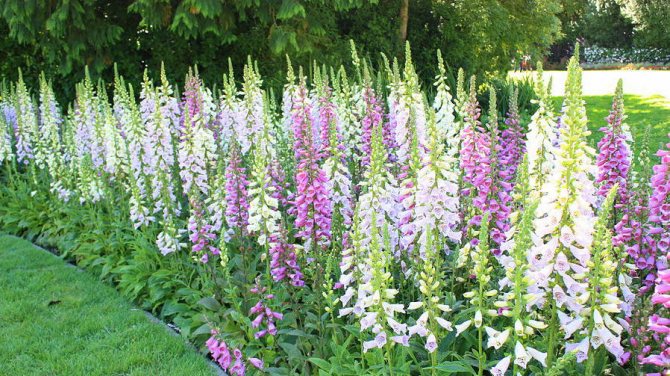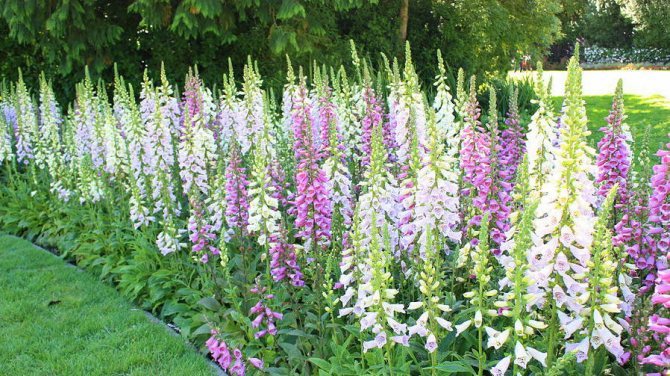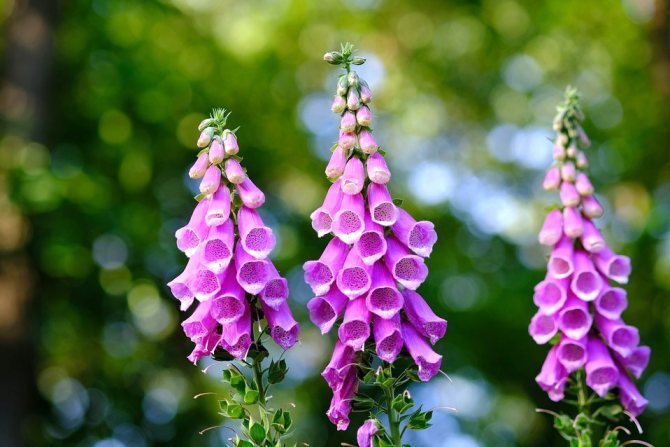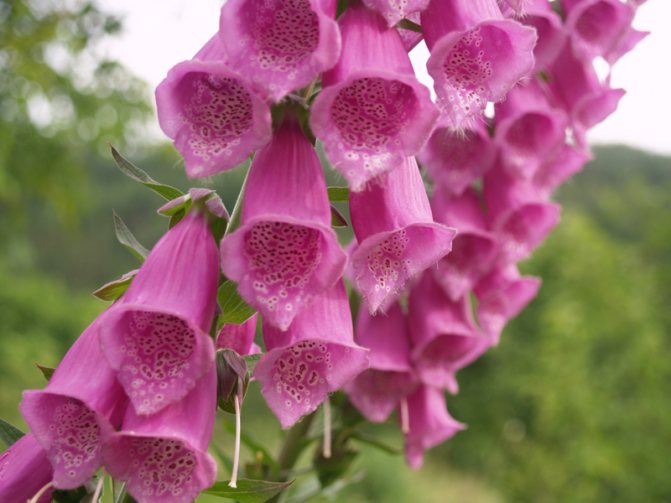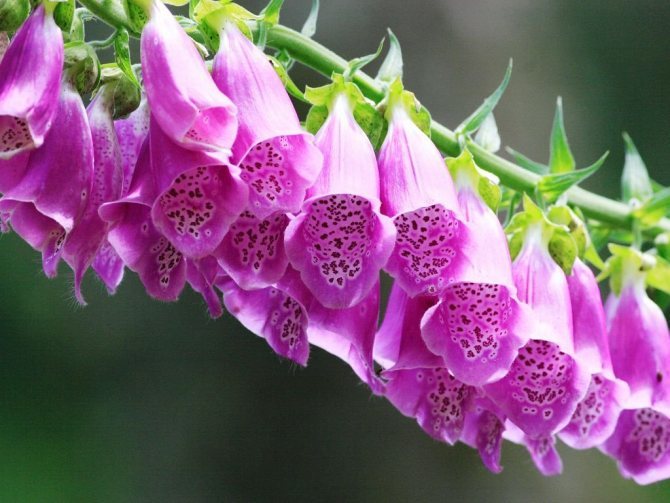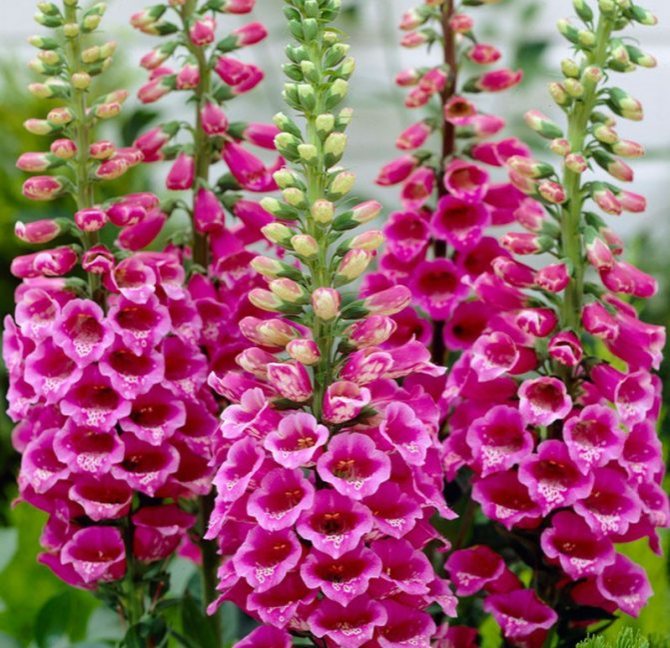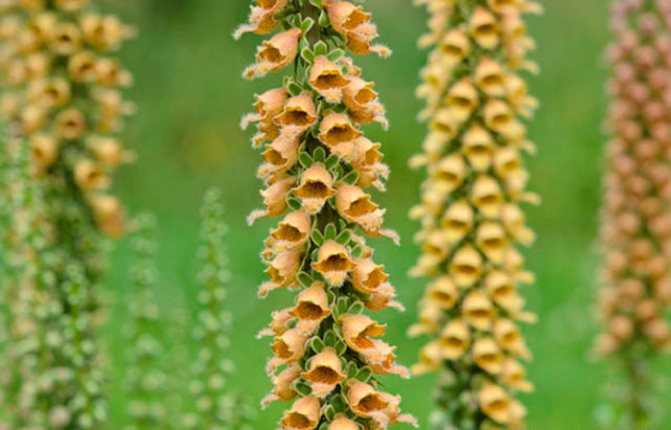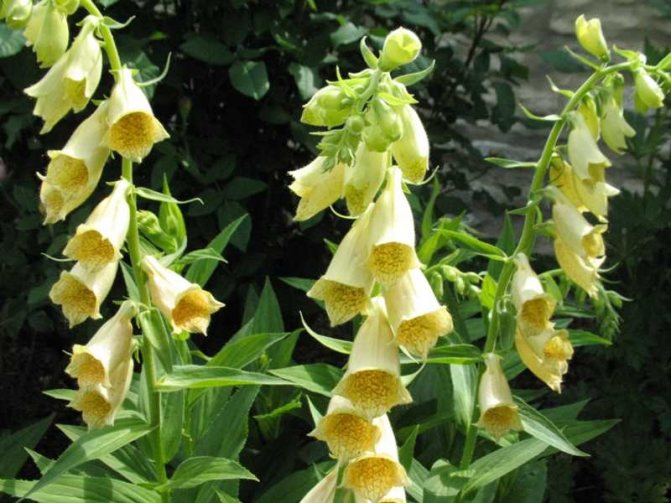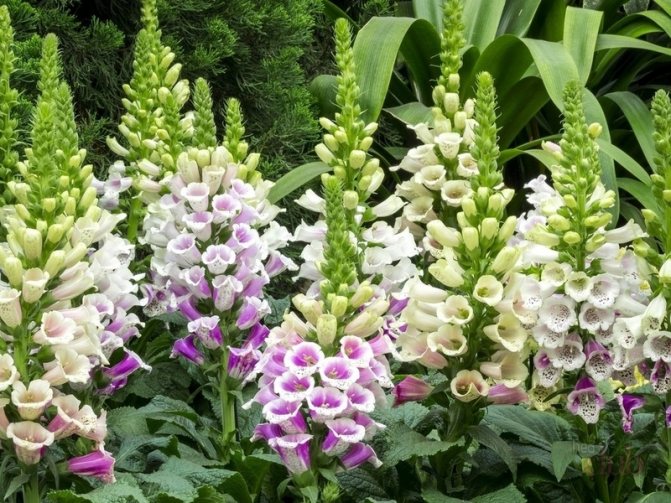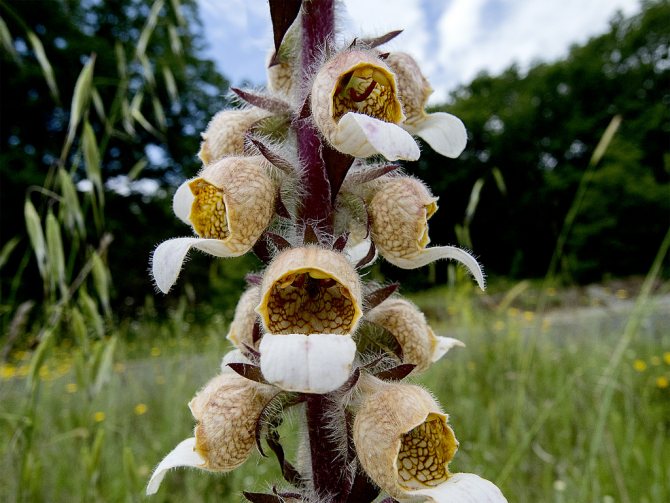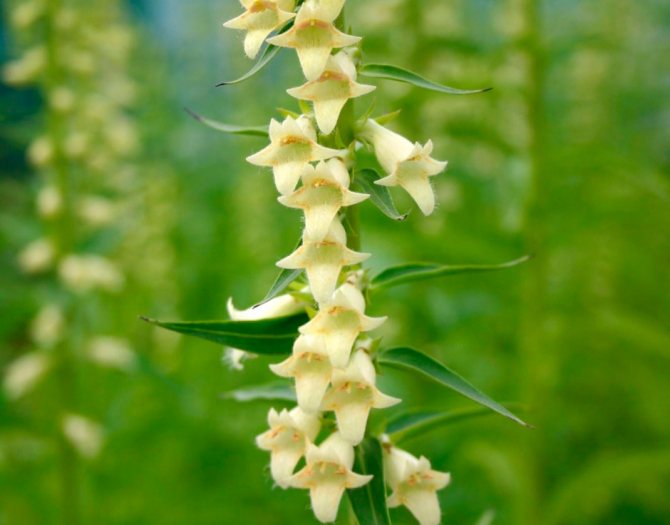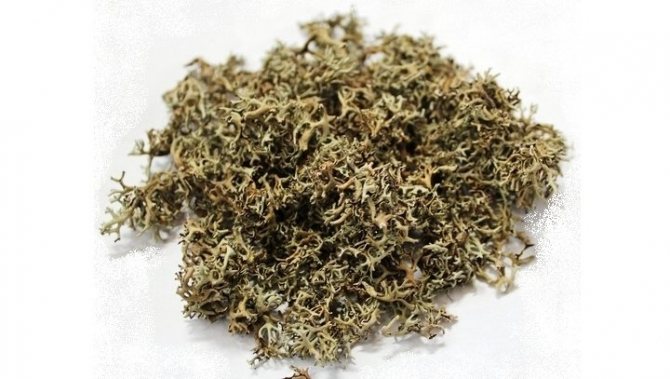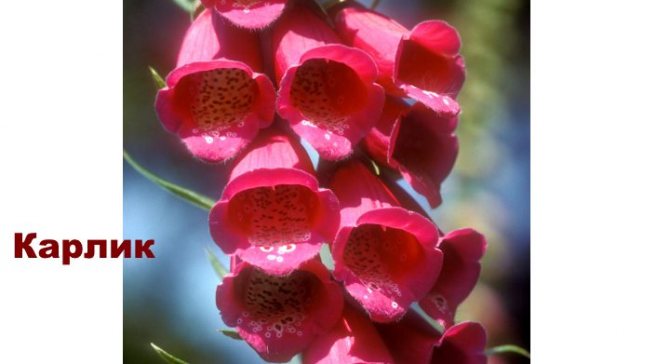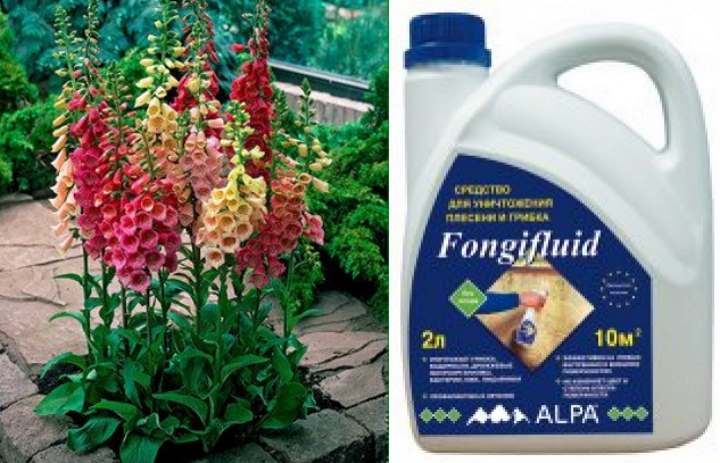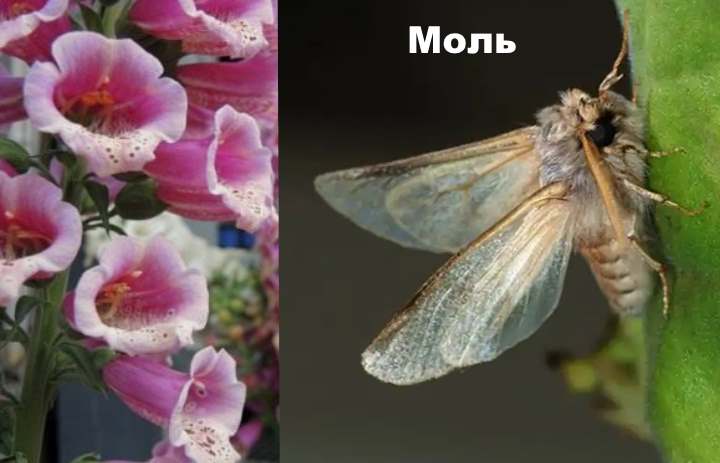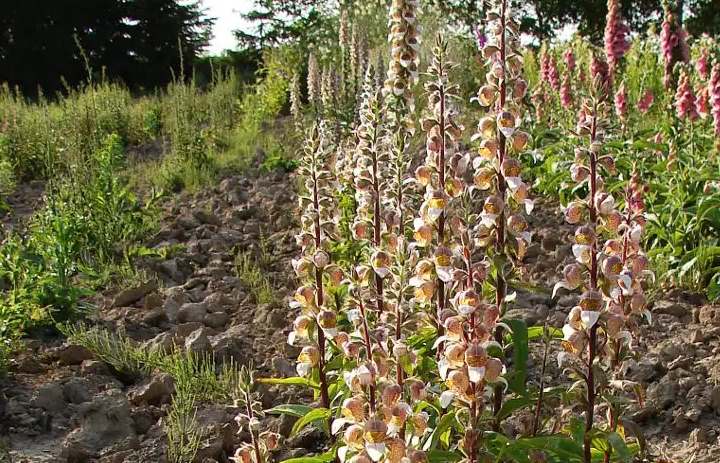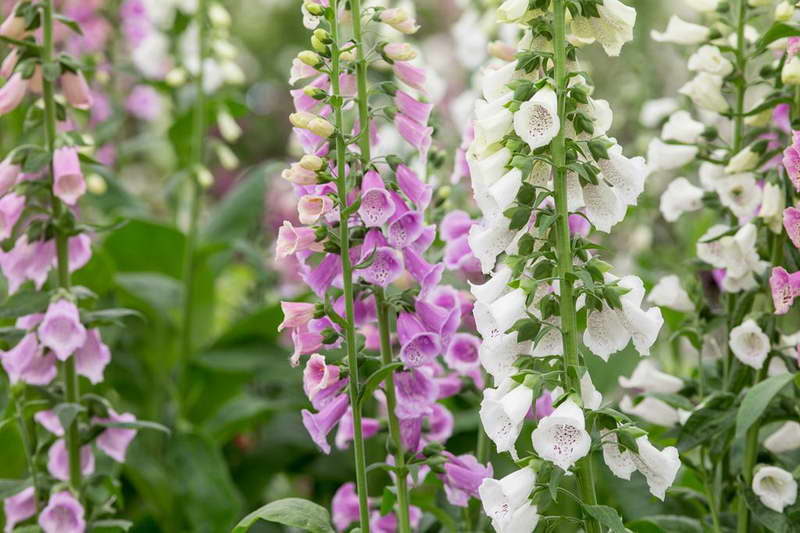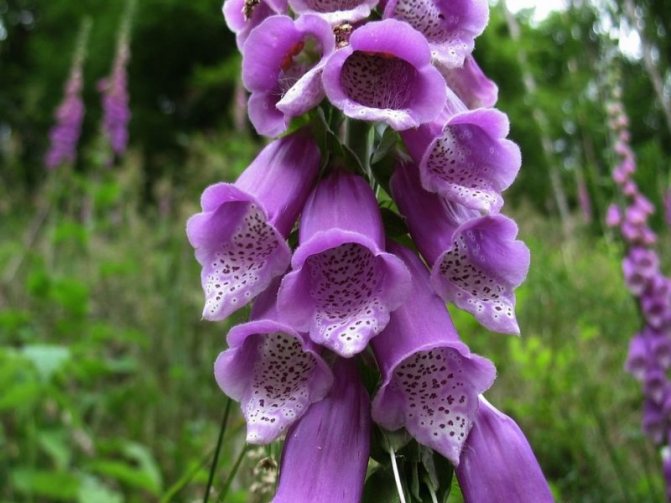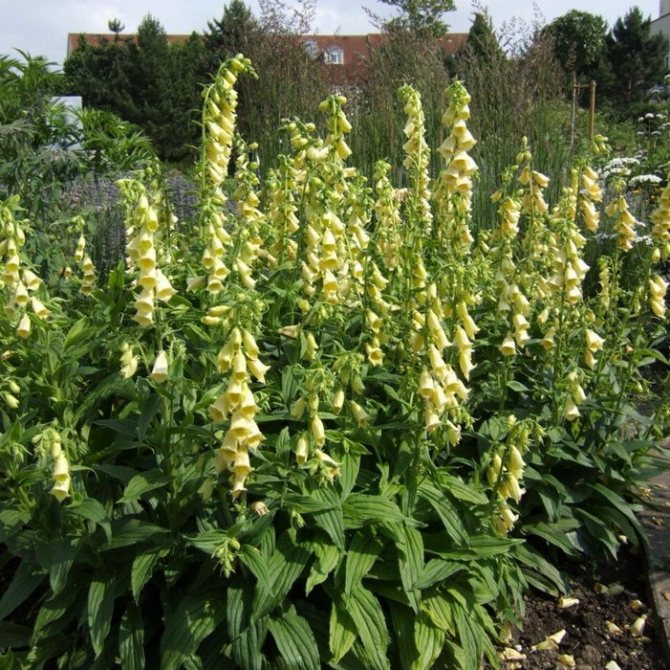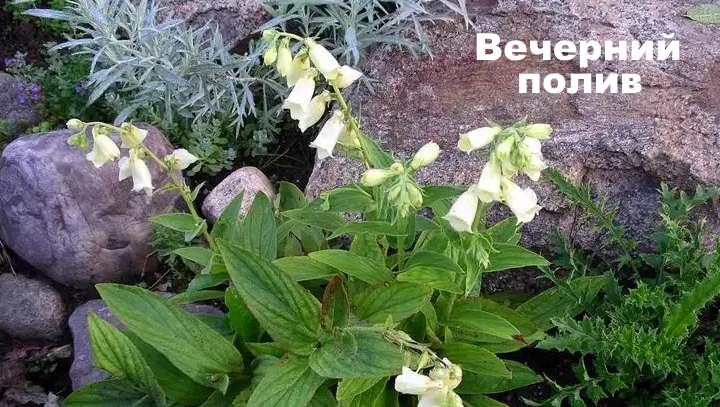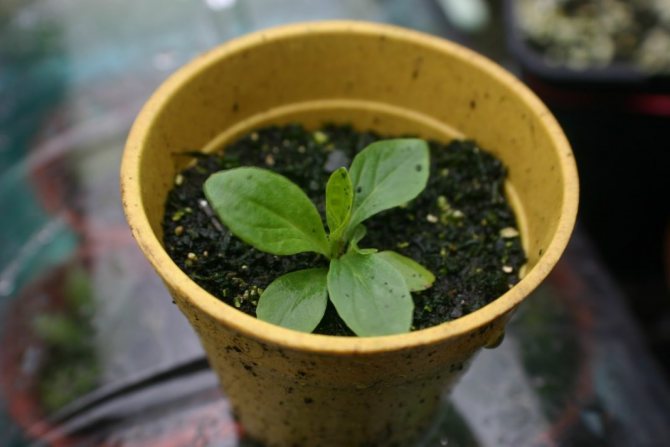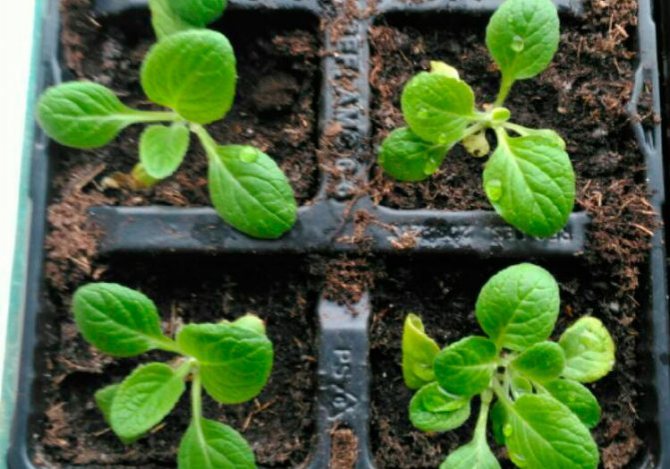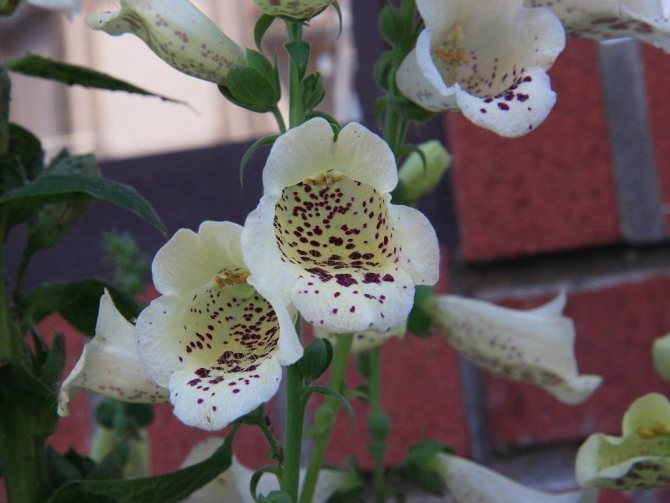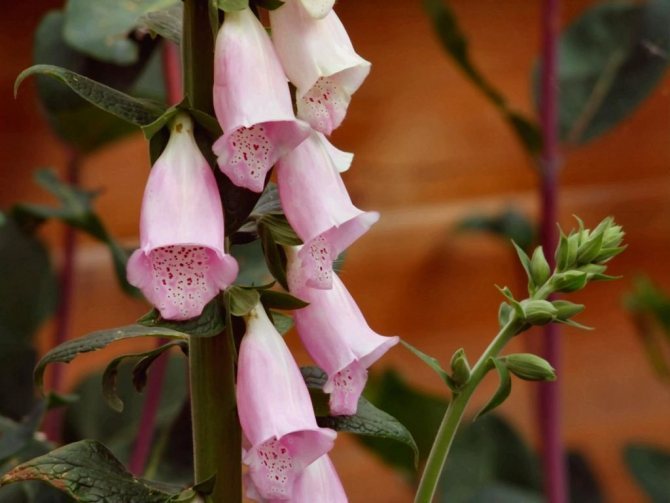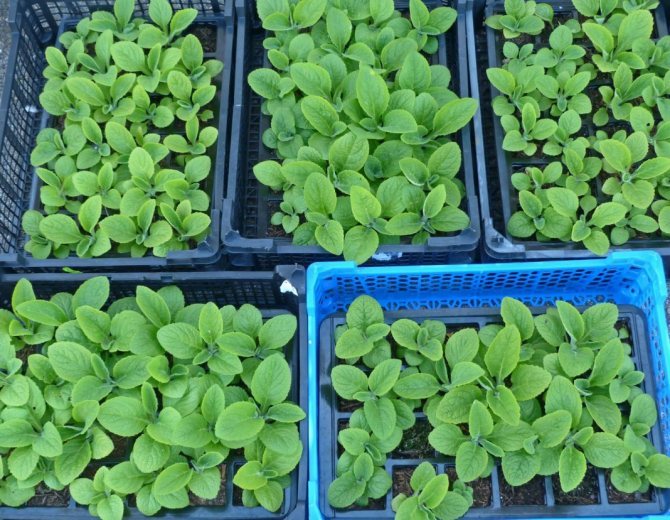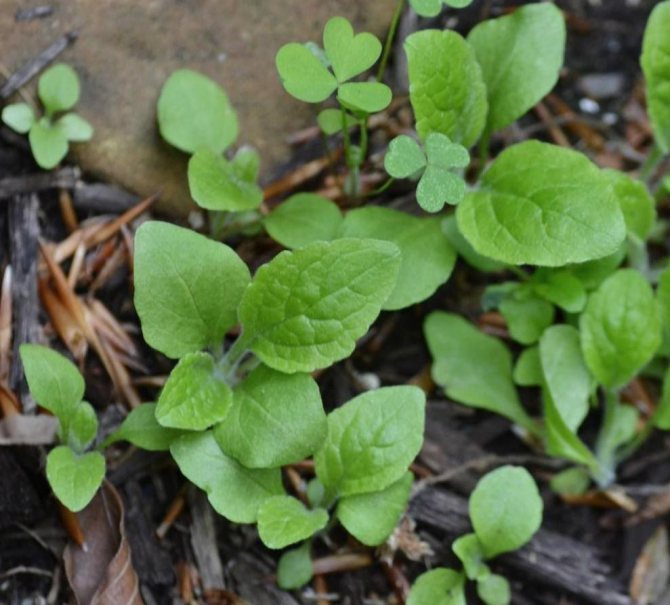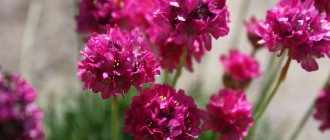Bright, tall and showy, the foxglove plant is a welcome guest on any garden plot. Everywhere this honey plant grows well with flowers similar to bells. The foxglove will feel great in the center of the flower garden in the sun and among the garden bushes in the backyard. The plant is very unpretentious in care, therefore it is very loved by gardeners. Growing a flower from seed does not present any particular difficulties, but it has its own characteristics.
- 2 Digitalis: growing from seed
2.1 Growing seedlings
- 2.2 Sowing seeds in open ground
Description and features of foxglove
The stems of a herbaceous plant are notable for their rigidity; they grow up to 1.5 m in height. The perennial is devoid of lateral processes, while the petiole leaves, mainly oval in shape, are collected in a rosette. The leaves of a dark green color have a pronounced relief, they grow up to 30 cm in length and up to 10 cm in width. The shadow side is densely covered with pile, while the top of the leaf is shiny and has bulges. In appearance, the foxglove resembles a shrub. In nature, digitalis can be found in forests, clearings and forest edges among other shrubs.
In summer, the foxglove has a multi-flowered inflorescence in the form of a brush, formed by bell-shaped flowers.
Shades range from red to white, and yellow is also found. Sometimes the pharynx is decorated with specks. Small seeds ripen after pollination. One plant brings about 2 million seeds, and their germination capacity lasts up to 3 years.
Purple, kurp-flowered and other types and varieties of foxglove
Despite the species diversity of foxglove, only 4 species are widespread in the middle lane.
Rusty
This species reaches a height of 120 cm and is covered with oblong foliage. Its dense inflorescences of bells grow up to 15 cm in length and form a wave closer to the edge. The calyx looks like an orchid, usually no more than 4 cm. Flowering occurs in the summer months. The yellow petals have a pink pattern and the throat has a golden hue inside. The species is highly regarded for its decorative qualities.
Purple (purple)
The biennial plant is represented by sparsely leaved stems, not higher than 1.5 m. There is pubescence of the shoots in the lower part of the leaf. In early summer, a brush-shaped inflorescence usually blooms, it is not symmetrical, formed by flowers no longer than 13 cm each. Petals of different shades are strewn with black dots. This species originated from Western Europe, where the plant is actively cultivated. There are many varieties, such as: spotted, large-flowered and gloxiniform.
The inflorescence is found both unilateral and pyramidal. The most commonly grown varieties:
- Alba. Petals are white, may be covered with dark dots.
- Mirabella. Inflorescences are multi-flowered, pink.
- Excelsior. This hybrid reaches a height of 1.8 m. It is notable for the fact that its flowers form a spiral.
- Peloric. The flowers of this variety are the largest among all varieties, located on a peduncle up to 1.8 m high.

Large-flowered
It grows up to 1.2 m in height, resembling a shrub in its appearance. The stems have a hard, fleecy cover.The leaves are elongated to a sharp edge, growing up to 25 cm in length and up to 7 cm in width.
In June, you can observe how the brush blooms at the top of the stem, it is strewn with small flowers. They are inherent in yellow shades, from the outer surface they are covered with pubescence. The corolla is divided to the edge into 5 petals. Found in Western Europe, Russia and Ukraine.
Woolly
A small perennial grows up to 80 cm in height. Small-flowered, in comparison with other varieties. Green leaves are collected in a dense rosette not high from the ground surface. On the shady side, they are bordered with cilia. In the middle of summer, a brush, covered with two-lipped cups, opens, often it resembles the shape of a pyramid. The flower is white, and as it moves away from the edge, it is covered with a brown pattern formed by veins. Among the many varieties and hybrids, the following are most common:
- Tapsi. The bells on the cluster are large, pink and crimson;
- Merton. An early flowering plant that can be seen already in late spring, the flowers are pink in color.
Blooms in July, and the flowering period is no more than 2 months. Possesses medicinal benefits. Found in natural conditions, mainly in Moldova.
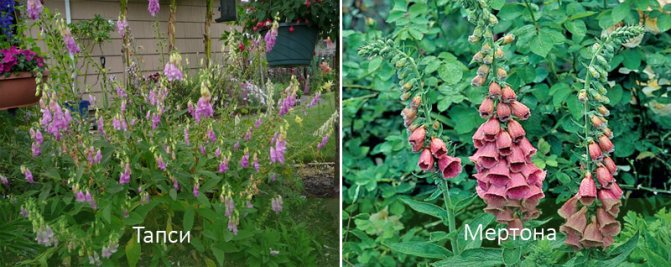

Which breeding method is better to choose?
Seed preparation and cultivation
Each plant produces a large amount of foxglove seeds. They are harvested in the fall, when the boxes are finally ripe. The most complete seeds are contained in capsules, which are located at the bottom of the plant. It is necessary to choose the moment when the fruit has already turned dark yellow or brown, but has not yet burst. The seeds are carefully scattered on a paper sheet in the shade to dry completely, and then carefully remove the remnants of the fruit. The collected seeds survive the winter well, and in the spring they are completely ready for planting.
In order for the seedlings to be friendly and fast, they pre-soak the seeds in a small amount of water. The second solution is to cover crops with lutrasil or film. The soil should be loose, light. No need to dig holes or furrows, just sprinkle the seeds with mud or peat a little. The rows should be located at a distance of 40-50 cm from each other, only in this case, adult plants will feel free. The emerging seedlings must be thinned: the less often the plants are planted, the higher their growth and larger peduncles will be. Spring cultivation of foxglove from seeds is the main method of propagation of a flower culture.


Seedlings appear at different times, depending on the type and air temperature - in the period from 8 to 15 days. They need to be lightly shaded and watered gently until they get stronger.
Propagation by basal processes
Leaving the largest and most lush flower stalks on the seeds, brushes from other specimens should be carefully trimmed and wait about 3 weeks. After this period, 6-8 small basal rosettes are formed near the base, which will soon give 7-8 small leaves. At this point, the sockets must be separated from the base and planted in the ground at the planned site.
When transplanting and watering, care should be taken that no water or soil gets into the core, otherwise the plant will die. Until the end of summer, the rosette will take root, give new leaves and will be ready to hibernate with adult specimens.To make the foxglove comfortably survive the winter, it can be covered with branches or fallen leaves.


Large buds of foxglove have many shades - from pale yellow to deep purple. The rich color scheme can be used both for creating multi-colored flower beds and for decorating buildings.
Thanks to proper care, already in the second year, the plant blooms with huge caps of bright flower stalks, turning a flower bed or garden into a piece of paradise.
Growing digitalis from seeds
An uncomplicated method, which includes several stages, is inferior to vegetative propagation only in speed.
Sowing seedlings
Sowing seeds is done in early spring and should include the following steps:
- Soaking in water, which needs to be replaced every 6 hours, while the entire soaking period should not exceed 1 week;
- Spreading seeds on the surface of the prepared soil;
- Sprinkling with a small amount of sand;
- Spraying with a growth stimulant;
- Covering the container with polyethylene or glass;
After that, they must be left for 2 weeks in a dark, warm place.
Growing seedlings
In foxglove, the first shoots appear rather late, after the formation of 2-3 leaves, it is necessary to dive the plant. The container is not particularly demanding - a cup is suitable for each separately or a common container. When planting together, it is worth maintaining a distance between seedlings of 10 cm. The seedlings are unpretentious, it is enough to water it as needed, carefully loosen the soil, prevent drafts and organize diffused lighting. 2 weeks before planting in open ground, it is necessary to carry out a hardening procedure, which is carried out as follows:
- You should take the plant out to the balcony for 5 minutes, provided that there is no precipitation and the weather is warm;
- Repeat the procedure daily, gradually increasing the time the foxglove stays in the fresh air.
Planting into the garden can be carried out after the plant can safely spend the whole day in the street.
Sowing seeds in open ground
Throughout the spring period, you can sow foxglove in open ground, but it is preferable to do this early.
First, it is worthwhile to properly prepare the soil: you need to carefully dig up, level and give it enough time for further subsidence.
When sowing, it is necessary to maintain a distance of 30 cm between the rows, while the planting depth should not exceed 2 cm.
The planted seed must be sprinkled with a small amount of earth. In cold weather, it is allowed to cover the seedlings with lutrasil. The minimum allowable distance between plants in one row is 10 cm.
The timing of planting seedlings in the ground
Seedlings are planted in late spring - early summer, focusing on the lunar planting calendar. It is allowed earlier, but it should be borne in mind that a young culture will not be able to survive return frosts. At the same time, the soil should be well warmed up, and at least 5 leaves should already grow on the seedlings.
Sowing foxglove should be in a place open and sufficiently lit, however, flowers can develop normally in partial shade. Areas located near deciduous plants are not suitable, since the soil around such crops is excessively moistened with periodic water retention. In such conditions, the foxglove will not die, but will be deprived of flowering.
Digitalis planting technology
Ground requirements:
- Looseness;
- Nutritional value;
- Water permeability, that is, there is no stagnation of moisture.
The soil is preliminarily weeded and dug up, and to a depth of at least 30 cm. After that, the soil is fertilized with compost at the rate of 5 kg per 1 m2.
When transplanting, the earthen lump of the plant must not be destroyed, since the roots are very fragile. After planting, be sure to tamp the soil and water it abundantly. Do not wait for flowering in the first year of growth, at this time the plant will only form a rosette.
Planting digitalis in open ground
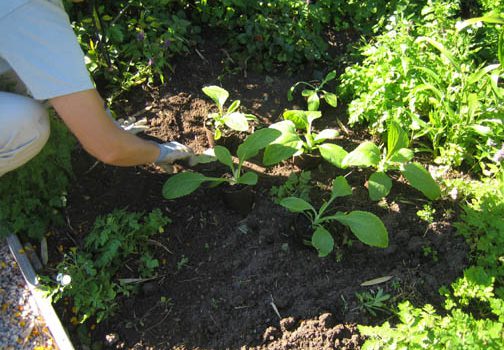

What time to plant
Planting digitalis seedlings into open soil is carried out after there is no threat of return frosts in spring (from the last days of May to the first days of June). When the time for planting comes, 5 or 6 true leaf plates should already form on the seedlings, and the soil should warm up very well.
It is best to choose an open and well-lit planting site, but these flowers can also be grown in light shade. The area under deciduous plants is not suitable for planting digitalis, because moisture retention is observed in the soil of the near-trunk circle, because of this, the digitalis may get wet or it will not bloom. Foliage flying around in autumn from trees is also undesirable for such a plant.
How to plant foxglove
The soil on the site should be nutritious, loose and permeable (no stagnation of moisture should be observed). The site for planting should be prepared in advance, for this, digging is carried out to the depth of the bayonet of the shovel, while humus or compost should be added to the soil (for 1 square meter of the site from 4 to 5 kilograms). During planting, a distance of 0.15-0.2 m must be observed between the bushes, and the distance between the rows should be from 0.25 to 0.3 m. In the prepared area, holes must first be made, the size of which should slightly exceed the size of the root system seedlings. Then the plants from the cups should be carefully transferred into the holes, while trying not to destroy the earthen lump. Seedlings from the container must be taken out very carefully together with the soil and placed in the holes. When the foxglove is planted, the surface of the soil must be tamped, and the plant must be well watered. In the first year after planting, a leaf rosette is formed in such a plant. For the first time, it will bloom only next season.
Foxglove after flowering
Proper planting and care guarantees good growth rates of digitalis and timely flowering, however, after it, you should not neglect the care of the perennial.
Due to the superficial location of the root system, there is a high probability of partial root exposure. To avoid this, especially in autumn, sprinkle the foxglove with a small layer of soil.


Quite a few varieties are notable for their resistance to low temperatures, but if a small amount of snow falls in winter, the plant runs the risk of freezing. It will not be superfluous to cover the outlet with sawdust or foliage. Shelter for the winter is especially important for young foxgloves.
The seeds can be harvested after the seed pods are fully ripe, which must be removed before they begin to burst. Seeds must be pre-dried in a well-ventilated room, then stored in paper bags and left in a dark, dry place.
Care
Spring-summer
After the snow melts, it is necessary to divert excess water from the foxglove plantings. Otherwise, flowering will be delayed or not at all.
During the spring-summer season, it is necessary:
- prune dry leaves,
- regularly remove weeds,
- loosen the soiltrying not to damage the shallow root system,
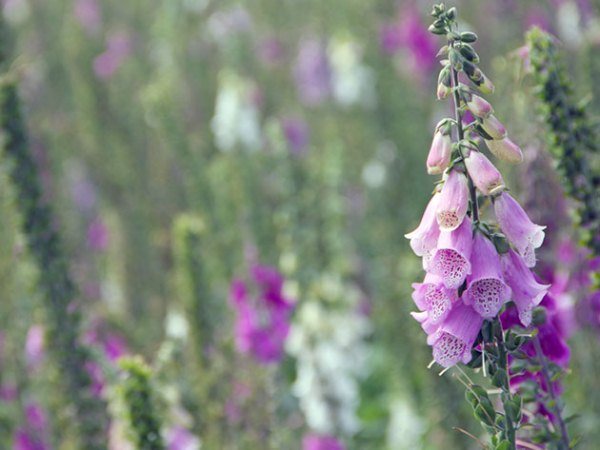

After watering or rain, shallow and gently loosen the soil around the plants
- introduce mineral and organic fertilizers,
- remove wilted corollasto prolong flowering, cut off faded peduncles,
- remove seed podsif digitalis self-seeding is not supposed to reproduce.
To make the digitalis flowers larger, leave the first peduncle and remove the rest. After cutting the peduncles, new arrows grow.
Autumn
- collect seedsif they are needed for digitalis breeding. Collect the lower boxes when they turn brown or yellow,
- prune all peduncles,
- sprinkle with a dense layer of soil the bare roots of digitalis,
- cover new crops leaves and branches. Adult plants are covered only in the absence of snow cover and expected frosts.
Pruning
In the spring, dry leaves are cut off. During flowering, in order to prolong it, wilted flowers are removed. Completely faded peduncles are cut off.
In autumn, when preparing plants for wintering, all peduncles are cut off.
Top dressing


Feed the perennial periodically to ensure lush blooms
In the spring and at the beginning of flowering, they are fed with complex mineral fertilizers. Fertilizers containing nitrogen are applied twice a season.
Vegetative reproduction of foxglove
Such reproduction is carried out using the basal processes. First, you need to get rid of the brushes that have already faded and wilted, while you can not help touching the dense inflorescences - they will come in handy for collecting seeds. After 3 weeks, at the base of the cut plants, the basal processes will sprout. Each of the root rosettes will acquire 7-8 leaf plates, which must be carefully removed and transplanted. The shoots will get stronger until autumn and will be able to safely withstand the coming winter. The young plant will acquire peduncles and bloom no later than the next season.
Diseases and pests
Powdery mildew. The fungus spreads at high speed by air, as well as with irrigation water and through tools. The affected plant undergoes yellowing, shrivels and dies. At the first sign of the disease, the affected parts should be disposed of, then the digitalis should be treated immediately with a fungicide. If the disease was not eliminated in the initial stages, then in the later stages, the plant can no longer be saved.
Root rot. Foxglove affected by this disease should be destroyed in order to stop further spread. Then the place where the diseased plant grew must be treated with a fungicide.
Leaf spot. It occurs on leaves and stems as a result of the activity of various pathogens. This is a symptom of the death of the affected area. The disease affects both young and mature plants. The disease leads to premature fall of leaves, their drying and deformation; weakens the immune system of digitalis.
Pest insects. The plant is susceptible to attacks by various types of aphids, which are carriers of various infections. The pest is easy to remove by treating the foxglove with an insecticide.
Top dressing and watering
Not only the foxglove planting is noteworthy. And watering with top dressing is of great importance. After you plant the shoots from the seedlings in a new place, wait a week, and then start feeding with fertilizers. The first procedure is carried out with ammonium nitrate. 15 g of the substance is enough for one bucket of water. Apply compound fertilizer after two weeks. Mulch the soil for good development of the bushes. Feed perennial adult bushes 2-3 times a season with mineral fertilizers.
Water the foxglove bushes abundantly and regularly, just make sure that no water gets into the plant. Leaves are afraid of moisture. Remember that the plant loves drainage soil. If the flowers are properly cared for, they will feel good both in the shade and in the sun. Loosen the soil around mature shrubs regularly. If the roots of a plant are suddenly exposed, then be sure to huddle them.
Mr. Dachnik informs: the harm and benefits of digitalis
Previously, healers used digitalis to treat various diseases, used as pain relievers for skin diseases, as well as to cleanse the body with constipation. However, when a certain concentration of foxglove was exceeded, the drug caused nausea, diarrhea and was often fatal.
In the 18th century, the flower began to be used in traditional medicine, mainly for the treatment of cardiovascular diseases. Currently, digitalis is used to:
- Strengthen the walls of blood vessels;
- Normalize blood supply to muscles and tissues;
- Improvement of hemodynamic characteristics;
- Fight against cardiosclerosis, hypertension, tachycardia;
- Normalize heart rate.
Woolly foxglove is used more often than others as a raw material for medicines. Organic acids and glycosides are isolated from it. The foliage is crushed to the state of a powder, which is included in the composition of medicines. Alternative medicine includes many types of digitalis tinctures.
All types of foxglove contain poison that is dangerous to health, so it is not recommended to resort to self-medication with this plant. It is especially contraindicated for people with chronic lung and heart problems, suffering from gastric tachycardia, as well as young children and pregnant women.
Use may cause rashes, itching, vomiting, many signs of food poisoning, respiratory failure, body cramps, and other similar symptoms. With prolonged use, anorexia, loss of appetite and hallucinations may develop.
The healing properties of digitalis
Traditional medicine has long recognized the efficacy of digitalis drugs. They are used for heart failure and circulatory problems. The drug with foxglove eliminates attacks of atrial fibrillation, improves blood supply to muscles, fights cardiosclerosis, tachycardia, hypertension and other diseases of the circulatory system. In addition, in folk medicine, a decoction of the leaves is used to combat epilepsy, skin inflammation, fever, pain and bleeding.
Despite the significant medicinal properties, even a minor overdose causes severe poisoning, so it is advisable to buy ready-made drugs in a pharmacy and take them as prescribed by a doctor, and not prepare the drugs yourself and self-medicate.
Post Views: 1


